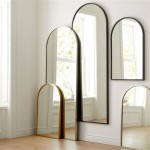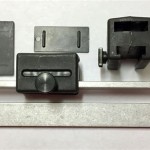Mirror Wall Mount Hardware: A Comprehensive Guide
Selecting the appropriate hardware for mounting a mirror is crucial for both safety and aesthetics. The weight, size, and location of the mirror all play a significant role in determining which mounting method and hardware are most suitable. This guide explores the various types of mirror wall mount hardware available, their applications, and key considerations for installation.
Key Considerations for Choosing Mirror Mount Hardware
- Mirror weight and dimensions.
- Wall material (drywall, concrete, plaster).
- Desired aesthetic (visible or hidden hardware).
- Location and environment (bathroom, high-traffic area).
Types of Mirror Wall Mount Hardware
Several types of mirror mount hardware cater to different needs and preferences. Understanding the advantages and disadvantages of each type allows for an informed decision.
J-Clips
- Offer a simple and cost-effective solution.
- Typically used for lighter mirrors.
- Provide a subtle, minimalist look.
- May require additional support for larger or heavier mirrors.
L-Brackets
- Suitable for medium-weight mirrors.
- Offer greater stability than J-clips.
- Can be used with or without adhesive.
- Available in various sizes and finishes.
D-Rings and Wire
- Traditional method for hanging framed mirrors.
- Allows for easy leveling adjustments.
- Requires wall anchors or hooks.
- Hardware may be partially visible.
French Cleats
- Provide a strong and secure mounting solution for heavy mirrors.
- Offer a flush, seamless appearance.
- Require precise installation.
- Ideal for large, frameless mirrors.
Adhesive
- Suitable for lightweight mirrors on smooth, non-porous surfaces.
- Offers a clean, hardware-free look.
- Not recommended for high-humidity environments.
- May damage walls upon removal.
Mirror Mounting Clips with Screws
- Combine the security of screws with the discreetness of clips.
- Suitable for a wide range of mirror sizes and weights.
- Offer good stability and support.
- Often used with decorative caps to conceal screws.
Heavy-Duty Mirror Hangers
- Designed for oversized or exceptionally heavy mirrors.
- Provide maximum weight capacity and stability.
- Often feature multiple fixing points for added security.
- May require professional installation.
Installation Best Practices
Proper installation is essential for ensuring the safety and longevity of the mirror. Following recommended practices will minimize the risk of damage and ensure a secure fit.
Locating Studs
- Using a stud finder is crucial for secure mounting, especially for heavier mirrors.
- Studs provide the strongest anchoring points in a wall.
- If studs are not available, appropriate wall anchors must be used.
Using Appropriate Wall Anchors
- Selecting the correct type of wall anchor is essential for non-stud mounting.
- Consider the wall material and the weight of the mirror.
- Toggle bolts, molly bolts, and plastic anchors are common options.
Pre-Drilling Pilot Holes
- Pre-drilling pilot holes prevents cracking and splitting, particularly in harder wall materials.
- Use a drill bit slightly smaller than the screw diameter.
- This ensures a clean and secure fit for the screws.
Measuring and Marking
- Accurate measurements are critical for proper alignment and stability.
- Use a level to ensure the mirror hangs straight.
- Mark the desired location of the hardware on the wall and the back of the mirror.
Safety Precautions
- Always wear appropriate safety glasses when drilling.
- Use gloves to protect hands from sharp edges and hardware.
- Consider using a second person for assistance with larger or heavier mirrors.
Choosing the Right Hardware for Your Wall Type
Different wall materials require specific types of hardware for secure mounting.
Drywall
- Hollow-wall anchors are typically suitable for lighter mirrors.
- Toggle bolts or molly bolts are recommended for heavier mirrors.
- Ensure anchors are appropriate for the weight and thickness of the drywall.
Concrete or Brick
- Concrete screws or masonry anchors are required for these materials.
- Pre-drilling pilot holes is essential.
- Use a hammer drill for easier installation.
Plaster
- Plaster walls can be brittle, requiring specialized anchors.
- Expansion anchors or toggle bolts are often suitable.
- Consider the age and condition of the plaster when choosing hardware.
By considering these factors and following best practices, individuals can ensure a secure and aesthetically pleasing mirror installation.

Glacier Bay Mirror Mounting Hanging Hardware Kit 805254 The Home Depot

Ook 3 8 In Offset Clip With Hardware Pack 50234 The Home Depot

12 Clear Mirror Holder Clips Wall Mounting Transpa Brackets S Anchors 1 Baker

Ovente 7 Wall Mount Makeup Mirror 1x 10x Magnifier Adjustable Spinning Double Sided Round Reflection Extend Retractable Folding Arm Bathroom Vanity Décor Nickel Brushed Mnlfw70br1x10x Com

Moon Mirror 24 X 36 Inch Pivoted Rectangular Wall Mounted Vanity W New Zealand Pinewood Frame No Distortion Glass Mounting Hardware Black Target

6 X Clear Mirror Wall Mounting Clip Bracket 1 4 S And Anchors

Bathroom Mirror For Wall Black

Klajowp 36 In W X 24 H Small Rectangular Framed Wall Mounted Bathroom Vanity Mirror Black Rm01 6090 120 The Home Depot

Round Polished Silver Pivot Mirror Clips Hardware Tilting Ancho Hamilton Hills

Nameeks 99258 Cr 5x Windisch Wall Mounted Brass Led Warm Light Mirror With Magnification Chrome 979 80 Focal Point Top Quality Hardware And Plumbing Kitchen Bath








